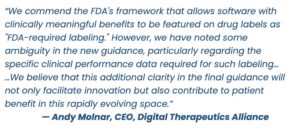PDURS: Insights for Pharma’s Digital Health and Innovation Teams
Navigating the FDA's draft guidelines on Prescription Drug Use Related Software (PDURS)
The FDA’s new Draft Guidelines for Prescription Drug Use Related Software (PDURS) are shaping the future of digital health in the pharmaceutical industry. These guidelines aim to

ensure the safety and efficacy of software that supports prescription drug use, marking a pivotal moment for digital health professionals. As executives at the forefront of pharmaceutical digital innovation, understanding the nuances of these guidelines and the industry’s response is crucial to navigating this regulatory landscape and leveraging emerging opportunities.
Overview of the FDA’s PDURS Guidelines
The FDA’s PDURS guidelines address software that plays a supportive role in the use of prescription drugs. This includes a wide array of applications, from mobile apps that track medication adherence to sophisticated analytics platforms that optimize treatment outcomes. The guidelines outline several key areas:
- Risk-Based Classification: Software will be classified based on its risk to patient safety, with higher-risk applications requiring more stringent evidence and controls.
- Evidence of Effectiveness: Companies must provide robust evidence to demonstrate that their software effectively supports the use of the prescription drug in question.
- User Interface and Usability: Emphasis is placed on designing user-friendly interfaces and providing clear instructions to ensure proper use by patients and healthcare providers.
- Interoperability: The guidelines stress the need for software to integrate seamlessly with other digital health systems and electronic health records (EHRs).
- Post-Market Surveillance: Continuous monitoring and updating of the software post-approval are essential to address emerging safety concerns and improve functionality.
Industry Response and Current Thinking
The PDURS guidelines have elicited a range of responses from digital health professionals and industry groups, reflecting both support and constructive critique.
Digital Therapeutics Alliance (DTA)
The Digital Therapeutics Alliance (DTA), the leading international organization on digital therapeutic thought leadership and education, has provided a thoughtful response to the FDA’s draft guidelines. The DTA generally supports the FDA’s efforts to establish clear regulatory standards for digital health products, recognizing the importance of ensuring patient safety and efficacy. However, they have highlighted several areas for further consideration:
- Clarity and Specificity: The DTA has called for greater clarity and specificity in the guidelines to help developers understand the exact requirements for different types of software. This includes more detailed examples of risk classification and evidence requirements.

- Flexibility and Innovation: While supporting robust evidence requirements, the DTA emphasizes the need for flexibility to accommodate innovative technologies and methodologies. They advocate for a balanced approach that allows for the rapid evolution of digital health tools while maintaining high standards of safety and effectiveness.
- Collaboration and Engagement: The DTA encourages ongoing collaboration between the FDA and industry stakeholders to refine the guidelines. This includes regular updates based on new evidence and technological advancements, as well as mechanisms for industry feedback.
- Global Harmonization: Recognizing the global nature of digital health, the DTA stresses the importance of harmonizing FDA guidelines with international standards. This would help streamline regulatory processes for companies operating in multiple markets and ensure consistent safety and efficacy standards worldwide.
Other Industry Insights
Beyond the DTA, other digital health professionals and organizations have also weighed in on the draft guidelines:
- Focus on User-Centric Design: Many experts highlight the importance of user-centric design principles. Ensuring that software is intuitive and easy to use can significantly enhance patient engagement and adherence, ultimately leading to better health outcomes.
- Emphasis on Real-World Evidence: The growing emphasis on real-world evidence is seen as a positive development. By leveraging real-world data, companies can generate more robust evidence of their software’s effectiveness in diverse patient populations and real-world settings.
- Need for Clear Implementation Pathways: Clear guidance on the implementation pathways for PDURS is crucial. Industry professionals have called for detailed procedural steps and timelines to help companies navigate the regulatory process efficiently.
Preparing for the Future
For digital and innovation executives in the pharmaceutical industry, preparing for the PDURS guidelines involves several strategic actions:
- Stay Informed and Engaged: Regularly monitor updates from the FDA and industry groups like the DTA. Participate in public consultations and provide feedback to help shape the final guidelines.
- Invest in Compliance and Quality Assurance: Ensure that your development processes align with the PDURS requirements. Invest in quality assurance measures, including user-centric design, evidence generation, and post-market surveillance.
- Collaborate with Stakeholders: Foster collaboration with regulatory bodies, industry groups, and other stakeholders. Engage in dialogue and partnerships to stay ahead of regulatory developments and share best practices.
- Leverage Technology and Innovation: Embrace innovative technologies and methodologies to meet the PDURS requirements. This includes leveraging real-world data, artificial intelligence, and machine learning to generate robust evidence and enhance software functionality.
Conclusion
The FDA’s new Draft Guidelines for Prescription Drug Use Related Software represent a significant milestone in the regulation of digital health tools. For pharmaceutical digital and innovation executives, understanding the current thinking about these guidelines and the industry’s response is essential to navigating this evolving landscape. By staying informed, investing in compliance, collaborating with stakeholders, and leveraging innovation, executives can ensure their digital health products meet regulatory standards and deliver meaningful benefits to patients.
Let’s Talk About Medisafe and PDURS:
